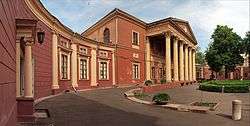Odessa Art Museum
| Одеський художній музей | |
 | |
| Established | 6 November 1899 |
|---|---|
| Location | Sofiyska 5a, Odessa |
| Type | art museum |
| Director | Vitaliy Abramov |
| Website |
ofam |
Odessa Art Museum (Ukrainian: Одеський художній музей) is one of the principal art galleries of the city of Odessa. Founded in 1899, it occupies the Potocki Palace, itself a monument of early 19th century architecture. The museum now houses more than 10 thousand pieces of art, including paintings by some of the best-known Russian and Ukranian artists of late 19th and early 20th century.
History
The palace that now houses the gallery is one of the oldest palaces of Odessa. It was ordered by Seweryn Potocki, a former Polish member of parliament who after the partitions of Poland swore loyalty to the tsar of Russia and eventually became a noted Russian diplomat and an ambassador to the Kingdom of Naples. Potocki was also a wealthy landowner and one of his properties, the village of Severinovka named after him contained a quarry of light limestone, from which both the palace and most of Odessa's public buildings were built.[1]

The construction started in 1805 and was supervised by Francesco Boffo,[2] a noted Italian architect and the author of many palaces and public buildings in Odessa and the Crimea. Construction of the main building was ready by 1810, though due to Napoleonic Wars works on internal furnishing did not commence until 1824 and were finished by 1828.[3]
The neoclassical building is a typical magnate residence of the epoch, with two floors, a large portico with a tympanum supported by six classical columns. The main building is joined to the side wings by semi-circular galleries, forming a Cour d'honneur in front of the palace. Behind it a small English-style landscape garden was created, with a romantic grotto. The interior design is mostly an eclectic mixture of various styles popular in early 19th century.
Seweryn Potocki, who died in 1829, did not see the palace completed. Instead, it was inherited by his distant relative, Olga Potocka, daughter to Stanisław Szczęsny Potocki. Potocka married Lev Naryshkin; although the palace remained her personal property, it is sometimes incorrectly referred to as Naryshkin Palace. In 1888 the building was sold to the mayor of Odessa, Grigorios Maraslis who then sold it in 1892 to the Odessa Society of Fine Arts.[2] It took 9 more years to complete the first collection. Finally, Odessa Art Museum was opened on 6 November 1899. The core of the initial collection was formed by paintings donated to the museum by the St. Petersburg Imperial Academy of Arts.
Collection

The collection of the Odessa Art Museum covers all art forms: painting, drawing, sculpture, decorative arts and averaging more than 10,000 works. In the exhibition, located in 26 halls, are painter's works of the 16th–18th centuries and secular portraits of the 17th century.
Of note are numerous works of Ivan Aivazovsky and some early paintings of Wassily Kandinsky. There is also a large collection of the Peredvizhniki movement, as well as paintings and other works of art by, among others, Ivan Kramskoi, Alexei Savrasov, Isaac Levitan, Ivan Shishkin, Arkhip Kuindzhi, Ilya Repin, Vasily Surikov, Alexandre Benois, Kyriak Kostandi, Valentin Serov, Mikhail Vrubel, Nicholas Roerich, Boris Kustodiev, Konstantin Somov, Pyotr Nilus and Nikolai Kuznetsov.
References
Citations
Bibliography
- various authors (2001). William Craft Brumfield; Boris Ananich, eds. Commerce in Russian Urban Culture, 1861–1914. Woodrow Wilson Center Press Series. Woodrow Wilson Center Press. p. 239. ISBN 9780801867507.
- Andrey Ivchenko (2005). Вся Украина. Путеводитель [Complete Ukraine: a guide] (in Russian). Kartografia. ISBN 966-631-618-8.
- Eduard Meissner (1820). "Description of Odessa". The Analectic Magazine. Philadelphia: Moses Thomas. 2: 362–364.
See also
Coordinates: 46°29′36″N 30°43′44″E / 46.4934°N 30.7288°E